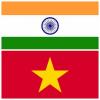India’s Art of Balancing in West Asia
The Indian foreign minister SM Krishna’s four nation visit to Israel, Jordan, Palestine and the UAE from January 8 to 11, 2012 has been seen as a beginning of “new approach ” in India’s foreign policy towards West Asia in general and the Arab Gulf region in particular. India has unequivocally accepted the paradigm that the relations with both Palestine as well as Israel are equally significant to its core national interests. Israel is important to India from defence, security and technology point of view, while Palestine is significant for humanitarian, ideological and strategic reasons.

